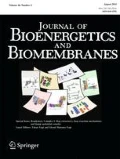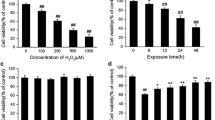Abstract
Propofol (2,6-diisopropylphenol) is an anaesthetic widely used for human sedation. Due to its intrinsic antioxidant properties, rapid induction of anaesthesia and fast recovery, it is employed in paediatric anaesthesia and in the intensive care of premature infants. Recent studies have pointed out that exposure to anaesthesia in the early stage of life might be responsible of long-lasting cognitive impairment. The apoptotic neurodegeneration induced by general anaesthetics (GA) involves mitochondrial impairment due to the inhibition of the OXPHOS machinery. In the present work, we aim to identify the main mitochondrial respiratory chain target of propofol toxicity and to evaluate the possible protective effect of CoQ10 supplementation. The propofol effect on the mitochondrial functionality was assayed in isolated mitochondria and in two cell lines (HeLa and T67) by measuring oxygen consumption rate. The protective effect of CoQ10 was assessed by measuring cells viability, NADH-oxidase activity and ATP/ADP ratio in cells treated with propofol. Our results show that propofol reduces cellular oxygen consumption rate acting mainly on mitochondrial Complex I. The kinetic analysis of Complex I inhibition indicates that propofol interferes with the Q module acting as a non-competitive inhibitor with higher affinity for the free form of the enzyme. Cells supplemented with CoQ10 are more resistant to propofol toxicity. Propofol exposure induces cellular damages due to mitochondrial impairment. The site of propofol inhibition on Complex I is the Q module. CoQ10 supplementation protects cells against the loss of energy suggesting its possible therapeutic role to minimizing the detrimental effects of general anaesthesia.






Similar content being viewed by others
Abbreviations
- mPTP:
-
Mitochondrial permeability transition pore
- GA:
-
General anaesthetics
- PRIS:
-
Propofol infusion Syndrome
- CoQ1 :
-
2,3-Dimethoxy-5-methyl-6-(3-methyl-2-butenyl)-1,4-benzoquinone
- DB:
-
2,3-Dimethoxy-5-methyl--6-decyl-1,4-benzoquinone, oxidized form
- DBH2:
-
2,3-Dimethoxy-5-methyl--6-decyl-1,4-benzoquinol, reduced form
- DCIP:
-
2,6-Dichlorophenolindophenol
- ETC:
-
Electron Transfer Chain
- BHM:
-
Bovine Heart Mitochondria
- TMPD:
-
N,N,N′,N′-Tetramethyl-p-phenylenediamine
- FCCP:
-
Carbonyl cyanide 4-(trifluoromethoxy)phenylhydrazone
- FMN:
-
Flavin mononucleotide
- MTT:
-
3-(4,5-Dimethyl-2-thiazolyl)-2,5-diphenyl-2H-tetrazolium bromide
- TMRE:
-
Tetramethylrhodamine ethyl ester
- ECAR:
-
Extracellular acidification rate
- OCR:
-
Oxygen consumption rate
- OXPHOS:
-
Oxidative phosphorylation
References
Apfelbaum JL, Grasela TH, Hug CC Jr, et al. (1993) The initial clinical experience of 1819 physicians in maintaining anesthesia with propofol: characteristics associated with prolonged time to awakening. Anesth Analg 77:S10–S14
Bercker S, Bert B, Bittigau P, et al. (2009) Neurodegeneration in newborn rats following propofol and Sevoflurane anesthesia. Neurotox Res 16:140–147. doi:10.1007/s12640-009-9063-8
Bergamini C, Moruzzi N, Sblendido A, et al. (2012) A water soluble CoQ10 formulation improves intracellular distribution and promotes mitochondrial respiration in cultured cells. PLoS One 7:1–11. doi:10.1371/journal.pone.0033712
Block RI, Thomas JJ, Bayman EO, et al. (2012) Are anesthesia and surgery during infancy associated with altered academic performance during childhood? Anesthesiology 117:494–503. doi:10.1097/ALN.0b013e3182644684
Boscolo A, Starr JA, Sanchez V, et al. (2012) The abolishment of anesthesia-induced cognitive impairment by timely protection of mitochondria in the developing rat brain: the importance of free oxygen radicals and mitochondrial integrity. Neurobiol Dis 45:1031–1041. doi:10.1016/j.nbd.2011.12.022
Branca D, Vincenti E, Scutari G (1995) Influence of the anesthetic 2,6-diisopropylphenol (propofol) on isolated rat heart mitochondria. Comp Biochem Physiol Part C Comp 110:41–45. doi:10.1016/0742-8413(94)00078-O
Brandt U (2006) Energy converting NADH:quinone oxidoreductase (complex I. Annu Rev Biochem 75:69–92. doi:10.1146/annurev.biochem.75.103004.142539
Cattano D, Young C, Straiko MMW, Olney JW (2008) Subanesthetic doses of propofol induce neuroapoptosis in the infant mouse brain. Anesth Analg 106:1712–1714. doi:10.1213/ane.0b013e318172ba0a
Cremona T, Kearney EB (1964) Studies on the respiratory chain-linked reduced Nicotinamide adenine dinucleotide dehydrogenase: VI. Further purification and properties of the enzyme from beef heart. J Biol Chem 239:2328–2334
Degli Esposti M, Ghelli A, Ratta M, et al. (1994) Natural substances (acetogenins) from the family Annonaceae are powerful inhibitors of mitochondrial NADH dehydrogenase (Complex I). Biochem J 301(Pt 1):161–167. doi:10.1016/j.bmcl.2003.11.021
Dobbing J, Sands J (1979) Comparative aspects of the brain growth spurt. Early Hum Dev 3:79–83. doi:10.1016/0378-3782(79)90022-7
Driessen J, Willems S, Dercksen S, et al. (2007) Anesthesia-related morbidity and mortality after surgery for muscle biopsy in children with mitochondrial defects. Paediatr Anaesth 17:16–21. doi:10.1111/j.1460-9592.2006.02043.x
Estabrook RW (1967) Mitochondrial respiratory control and the polarographic measurement of ADP:O ratios. Methods Enzymol 10:41–47. doi:10.1016/0076-6879(67)10010-4
Estornell E, Fato R, Castelluccio C, et al. (1992) Saturation kinetics of coenzyme Q in NADH and succinate oxidation in beef heart mitochondria. FEBS Lett 311:107–109. doi:10.1016/0014-5793(92)81378-Y
Estornell E, Fato R, Pallotti F, Lenaz G (1993) Assay conditions for the mitochondrial NADH:coenzyme Q oxidoreductase. FEBS Lett 332:127–131. doi:10.1016/0014-5793(93)80498-J
Fato R, Estornell E, Di Bernardo S, et al. (1996) Steady-state kinetics of the reduction of coenzyme Q analogs by complex I (NADH:ubiquinone oxidoreductase) in bovine heart mitochondria and submitochondrial particles. Biochemistry 35:2705–2716. doi:10.1021/bi9516034
Fato R, Bergamini C, Bortolus M, et al. (2009) Differential effects of mitochondrial complex I inhibitors on production of reactive oxygen species. Biochim Biophys Acta 1787:384–392. doi:10.1016/j.bbabio.2008.11.003
Fetoni AR, De Bartolo P, Eramo SLM, et al. (2013) Noise-induced hearing loss (NIHL) as a target of oxidative stress-mediated damage: cochlear and cortical responses after an increase in antioxidant defense. J Neurosci 33:4011–4023. doi:10.1523/JNEUROSCI.2282-12.2013
Fodale V, La Monaca E (2008) Propofol infusion syndrome: an overview of a perplexing disease. Drug Saf 31:293–303
Fredriksson A, Archer T, Alm H, et al. (2004) Neurofunctional deficits and potentiated apoptosis by neonatal NMDA antagonist administration. Behav Brain Res 153:367–376. doi:10.1016/j.bbr.2003.12.026
Fredriksson A, Pontén E, Gordh T, Eriksson P (2007) Neonatal exposure to a combination of N-methyl-D-aspartate and gamma-aminobutyric acid type a receptor anesthetic agents potentiates apoptotic neurodegeneration and persistent behavioral deficits. Anesthesiology 107:427–436. doi:10.1097/01.aoa.0000308309.23565.70
Gornall AG, Bardawill CJ, David MM (1949) Determination of serum proteins by means of the biuret reaction. J Biol Chem 177:751–766
Haase R, Sauer H, Eichler G (2005) Lactic acidosis following short-term propofol infusion may be an early warning of propofol infusion syndrome. J Neurosurg Anesthesiol 17:122–123
Istaphanous GK, Loepke AW (2009) General anesthetics and the developing brain. Curr Opin Anaesthesiol 22:368–373. doi:10.1097/ACO.0b013e3283294c9e
Javadov SA, Lim KH, Kerr PM, et al. (2000) Protection of hearts from reperfusion injury by propofol is associated with inhibition of the mitochondrial permeability transition. Cardiovasc Res 45:360–369
Jevtovic-Todorovic V, Hartman RE, Izumi Y, et al. (2003) Early exposure to common anesthetic agents causes widespread neurodegeneration in the developing rat brain and persistent learning deficits. J Neurosci 23:876–882. doi:10.1097/00008506-200307000-00029
Jones D (1981) Determination of pyridine dinucleotides in cell extracts by high-performance liquid chromatography. J Chromatogr 225:446–449
Kahraman S, Zup SL, McCarthy MM, Fiskum G (2008) GABAergic mechanism of propofol toxicity in immature neurons. J Neurosurg Anesthesiol 20:233–240. doi:10.1097/ANA.0b013e31817ec34d
Koch M, De Backer D, Vincent J (2004) Lactic acidosis: an early marker of propofol infusion syndrome? Intensive Care Med 30:522
Lauro GM, Di Lorenzo N, Grossi M, et al. (1986) Prostaglandin E2 as an immunomodulating factor released in vitro by human glioma cells. Acta Neuropathol 69:278–282. doi:10.1007/BF00688305
Leskovac V (2003) Comprehensive enzyme kinetics. Publisher Springer US, Copyright Springer Science+Business Media, New York
Marian M, Parrino C, Leo AM, et al. (1997) Effect of the intravenous anesthetic 2,6-diisopropylphenol on respiration and energy production by rat brain synaptosomes. Neurochem Res 22:287–292. doi:10.1023/A:1022438805337
Pallotti F, Lenaz G (2007) Isolation and Subfractionation of mitochondria from animal cells and tissue culture lines. Methods Cell Biol 80:3–44
Parke TJ, Stevens JE, Rice AS, et al. (1992) Metabolic acidosis and fatal myocardial failure after propofol infusion in children: five case reports. BMJ 305:613–616. doi:10.1136/bmj.305.6854.613
Paule MG, Li M, Allen RR, et al. (2011) Ketamine anesthesia during the first week of life can cause long-lasting cognitive deficits in rhesus monkeys. Neurotoxicol Teratol 33:220–230. doi:10.1016/j.ntt.2011.01.001
Pearn ML, Fellow Postdoctoral, Hu Y, et al. (2012) Propofol neurotoxicity is mediated by p75 neurotrophin receptor activation. Anesthesiology 116:352–361. doi:10.1097/ALN.0b013e318242a48c
Schenkman KA, Yan SL (2000) Propofol impairment of mitochondrial respiration in isolated perfused Guinea pig hearts determined by reflectance spectroscopy. Crit Care Med 28:172–177. doi:10.1097/00003246-200001000-00028
Schwartz D, Raghunathan K (2009) Anesthesia and mitochondrial disorders. Paediatr Anaesth 19:60–61
Sebel P, Lowdon J (1989) Propofol: a new intravenous anesthetic. Anesthesiology 71:260–277
Smith AL (1967) 13] preparation, properties, and conditions for assay of mitochondria: slaughterhouse material, small-scale. Methods Enzymol 10:81–86. doi:10.1016/0076-6879(67)10016-5
Smith S, Cottingham I, Ragan C (1980) Immunological assays of the NADH dehydrogenase content of bovine heart mitochondria and submitochondrial particles. FEBS Lett 110:279–282
Stratmann G (2011) Neurotoxicity of anesthetic drugs in the developing brain. Anesth Analg 113:1170–1179
Sztark F, Ichas F, Ouhabi R, et al. (1995) Effects of the anaesthetic propofol on the calcium-induced permeability transition of rat heart mitochondria: direct pore inhibition and shift of the gating potential. FEBS Lett 368:101–104. doi:10.1016/0014-5793(95)00610-L
Takada M, Ikenoya S, Yuzuriha T, Katayama K (1984) Simultaneous determination of reduced and oxidized ubiquinones. Methods Enzymol 105:147–155
Twaroski DM, Yan Y, Zaja I, et al. (2015) Altered mitochondrial dynamics contributes to propofol-induced cell death in human stem cell–derived neurons. Anesthesiology 123:1067–1083. doi:10.1097/ALN.0000000000000857
Vanlander AV, Okun JG, de Jaeger A, Smet J, De Latter E, et al. (2015) Possible pathogenic mechanism of propofol infusion syndrome involves coenzyme q. Anesthesiology 122:343–352
Wilder RT, Flick RP, Sprung J, et al. (2009) Early exposure to anesthesia and learning disabilities in a population-based birth cohort. Anesthesiology 110:796–804. doi:10.1097/01.anes.0000344728.34332.5d
Wolf A, Weir P, Segar P, et al. (2001) Impaired fatty acid oxidation in propofol infusion syndrome. Lancet 357:606–607. doi:10.1016/S0140-6736(00)04064-2
Wu, GJ, Tai YT, Chen TL, et al (2005) Propofol specifically inhibits mitochondrial membrane potential but not complex I NADH dehydrogenase activity, thus reducing cellular ATP biosynthesis and migration of macrophages. Ann N Y Acad Sci 168–176
Zou W-W, Xiao H-P, M-N G, et al. (2013) Propofol induces rat embryonic neural stem cell apoptosis by activating both extrinsic and intrinsic pathways. Mol Med Rep 7:1123–1128. doi:10.3892/mmr.2013.1298
Acknowledgments
The authors thank Professor Giorgio Lenaz M.D., Department of Biomedical and Neuromotor Sciences (DIBINEM), University of Bologna, Italy, for the stimulating discussions and for the critical reading of the paper.
Author information
Authors and Affiliations
Corresponding author
Ethics declarations
Conflict of interest
The authors declare that they have no conflict of interest.
Author contributions
C.B., N.M., F.V., and L.F. performed experiments, C.B., M.C.M. and R.F. conceived ideas, designed experiments, analysed results. C.B., N.M., J.G. and R.F. wrote the manuscript. All authors edited and reviewed the final manuscript.
Electronic supplementary material
ESM 1
(DOCX 166 kb)
Rights and permissions
About this article
Cite this article
Bergamini, C., Moruzzi, N., Volta, F. et al. Role of mitochondrial complex I and protective effect of CoQ10 supplementation in propofol induced cytotoxicity. J Bioenerg Biomembr 48, 413–423 (2016). https://doi.org/10.1007/s10863-016-9673-9
Received:
Accepted:
Published:
Issue Date:
DOI: https://doi.org/10.1007/s10863-016-9673-9




